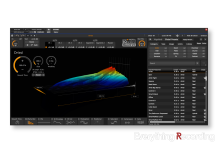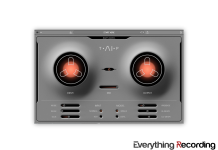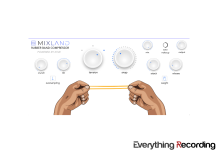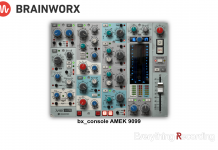The dbx 120XP Waveform Modeling engine is a secret weapon for engineers and producers who want earth shattering low end to tracks. Now this same tool can be used in your DAW.
SANTA CRUZ, CA, USA: Plugin Alliance, a new ‘Über-standard’ supporting all major plugin formats and uniting some of the best-known international audio companies under one virtual roof, is proud to announce availability of bx_subsynth — a unique processing plugin built around the digital heart and soul of the (discontinued) dbx 120XP Subharmonic Synthesizer, using founding Plugin Alliance development partner Brainworx’s M/S (Mid-Side) matrix technology to control the stereo field and add sub, punch, and saturation to sounds — as of March 3…
Inspired by its superior subharmonic synthesis, Brainworx began by making a meticulous model of the legendary dbx 120XP Subharmonic Synthesizer’s Waveform ModelingTM engine, which generates discrete bass frequencies one octave below whatever is fed into it. Indeed, this was the secret weapon of many DJs, audio post professionals, and mix engineers for adding clean and powerful low end to sounds while shaking anything and everything within earshot. But far from simply seeking to emulate what had gone before, Brainworx took to supersizing the feature set of the original processor from which it took that inspiration by implementing a whole host of fanciful features to take things even higher — or, better said, lower! The result? Tighter, clearer, bigger, and resonant sounding bass can be synthesized from even the most meagre of sounds, such is the unprecedented level of power brought by bx_subsynth.
So how, exactly, does bx_subsynth do what it does and, more to the point, why does it do it so well? For starters, bx_subsynth generates subharmonics in up to three discrete frequency bands verses the original hardware’s two; the addition of a higher (56-80 Hz) Synthesized Frequency bass band for resynthesis — searching for the dominant frequency in the range of approximately 112-160Hz to synthesize a sub- octave from it — allows anyone to capture and nosedive the fundamental frequencies of a much wider variety of instruments, including snare drum and acoustic guitar. The Tight Punch control — a 6th-order resonant Butterworth high-pass filter at the input that can be used with or without the subharmonics summed in — creates crystal-clear, body-thumping bass by adding a resonant sub-bass peak and filtering out unwanted lows below its cutoff frequency. Powerful Edge processing permits selecting from two modes of operation — Smooth and Harsh — that compress and saturate tracks to deliver super-compact or explosively-trashy drums and throbbing, in-your-face bass guitar. Get this, though… being a Brainworx-branded plugin, bx_subsynth is truly the surgeon’s knife of stereo imaging, of course — choose to process only the mid channel or both left and right channels, collapse the processed bass to super-tight mono, and stretch the stereo image for mile-wide mixing!
But bass EQ cannot do what bx_subsynth does. Discrete frequencies generated by bx_subsynth set aside more space across the bass frequency band for other instruments, so sub-synth bass can be jacked up without muddying mixes. Moreover, EQs cannot boost bass in a thin track that is lacking in bottom end to start with, whereas bx_subsynth does not just boost bass, but also adds new bottom end! Unlike psychoacoustic bass processors that trick the human brain into hearing ‘phantom’ subharmonics that are non-existent and cannot be physically felt, bx_subsynth adds real sub-bass that will shake your body — Boom! shake-shake-shake the room-style!
Seriously, bx_subsynth is a serious tool that can be applied to almost anything… retune drum tracks by dialling in higher subharmonics for rack toms and lower ones for the floor tom to create colossal, pounding drum fills; boost different subharmonics on a kick drum and bass guitar to separate their respective sounds in the mix for increased clarity and punch; add subterranean thunder to sustained left-hand octaves on piano tracks; automatically generate a perfectly synchronised bass line from the bottom strings played on an arpeggiated acoustic guitar track — two knob twists are all it takes to focus the bass line’s image dead-centre and massively widen the guitar’s stereo image by up to 400%!
Remastering engineers can use bx_subsynth to add a fat bottom end to thin vinyl masters and old recordings made on narrow-gauge multitrack tape recorders. Sound designers can pump up weak cinematic effects with terrifying lows. DJs can turbocharge their sound systems’ low end to woofer-shattering extremes. Whatever the application, this is one helluva bone-rattling big bottom end that can be felt as well as heard!
Here it is, then… as an indispensable tool that can totally transform the way that low-end sound is designed and processed, bx_subsynth is the Holy Grail for bass junkies. Just ask Dave Audé!
Legal Disclaimer: dbx and 120XP are registered trademarks of Harman, Inc. bx_subsynth was developed by Brainworx Music and Media GmbH based on its own modelling techniques. Neither Harman, dbx, or any of their affiliates have endorsed or sponsored bx_subsynth in any manner, or licensed any intellectual property for use in this product.
For more in-depth info, including several superb-sounding audio demos, please visit the dedicated bx_subsynth webpage here: https://www.plugin-alliance.com/en/products/bx_subsynth.html
bx_subsynth can be seen and heard in this tantalising trailer video here: https://www.youtube.com/watch?v=4TPFAVvelUw














